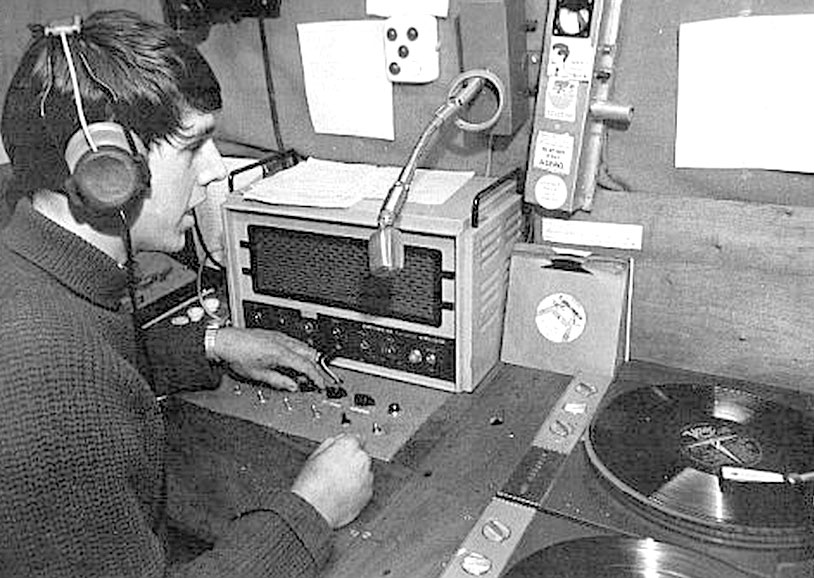We Want the Airwaves Back: Pirate Radio Inspiration
Community
I was assigned to write a piece about pirate radio for this month’s issue so I contacted pirate radio’s most infamous guru: Tecspectr. We made arrangements to meet, and later that week, he showed up at the SLUG office carrying an inconspicuous black shoulder bag. Tall and thin, an engineer by trade, I could tell right away that he was excited to get right down to business.
[Tecspectr can kick Slater’s ass any day]”Should we set it up?” he asked.
“Set what up?” I replied, not knowing what he was talking about.
“The radio station,” he said.
“What?” I said, still confused, “Fuck yeah.”
He went out to his car for what I was sure was going to be heavy equipment or maybe a laptop computer or something, but all he brought back was an eight-foot-long J-shaped antenna. He braced it in a potted plant and stuck it out the window, making sure not to touch the metal gutters. He ran a cable from there across the room to our coffee table on which he placed a small grey box, an eight-track mixer, a Discman, a set of headphones and a microphone. He hooked the headphones, the mic and the Discman to the mixer and plugged the mixer into the grey box, which he explained was a 4-watt PLL (phase lock loop) FM transmitter.
“That’s it,” he said. “We are now sitting at the controls of a pirate radio station.”
Pirate radio is exactly what the name implies, it is unlicensed radio transmission. For example, Tecspectr broadcasts on 95.9 FM, which is technically owned by a butt rock station in Logan. When the Spectr is on the air, you can tune your radio to 95.9 FM and instead of hearing Whitesnake and Poison rotated around five minute commercial blocks, you hear radical sociopolitical commentary and half-hour blocks of songs that you would never normally hear on the radio, or whatever the hell else he feels like putting on. The equipment is cheap and the process is simple. The transmitter, which Tecspectr ordered online from London (www.nrgkits.com) and assembled himself, cost less than $200; his mixer around $100; and his antenna, which he assembled from copper pipe, around $20. “Anybody can do this for under $500,” he says, “and it’s not rocket science.”
I talked to Tecspectr about pirate radio because he ran Black Ball Radio, an infamous and highly popular pirate Seattle station during 2000 to 2001 that broadcast 24-7 for a year.
“On July 4, 2000,” he explained, “the Fourth of July Black Ball was held on the historic art-deco ferry Kalakala, which is dry-docked in Lake Union in downtown Seattle. The whole scene was there. Bad Religion heard that I was broadcasting Internet radio, which, at that time, was brand new technology, and contacted me about doing a live show from the Black Ball using the transmitter they and Pearl Jam had used to broadcast on tour. The show went well and the bands decided since they weren’t using it, to give me their transmitter. Black Ball Radio was born, and it was huge.”
We got the broadcast going at SLUG HQ and took a drive to see how far we reached. We picked up a signal for seven blocks in each direction.
“Antenna placement is crucial; ours right now is terrible,” he said. “If we had the antenna on the roof with a 20-foot mast, we’d hit downtown and the University [from Sugarhouse] easily.”
The reasons behind pirate radio are simple. Music and other forms of media affect our lives, mass media is mass culture transfer. The people in charge of virtually every facet of mass media are only concerned with lining their pockets. They irresponsibly transfer the most marketable and usually worst aspects of American culture to the masses. Pirate radio fights against that. The air and its waves belong to the people. It should not be “owned.” Pirate radio brings power to the people.
When I asked him what advice he would give to someone starting a pirate radio station, Tecspectr told me, “Do it. Dig right in. But be careful. Know when to shut it off. Also, run it yourself, pirate radio is not run by committee.
“The possibilities are very exciting right now. Guttenberg invented moveable type 400 years ago and only in the last 50 have we made a major advance in mass media, especially with the Internet in the last 10. Think of this: five punk rockers live in five different cities. Each one has a transmitter. Each one collects mp3s from local bands and puts them on an Internet radio station [which is, for now, virtually unregulated]. The five kids hook their computers to their transmitters and suddenly you can turn on the radio in each of those five cities and suddenly you’re exposed to music you would have never otherwise heard.”
When Tecspectr gets back on the mic, he petitions his listeners.
“Let’s take back the airwaves. I cannot stress how easy this is. Please go do it.”
Listen for pirate radio on occasional Friday and Saturday nights on 95.9 FM. Check out www.slugmag.com and www.hektik.org for local Internet radio and www.shoutcast.com for Internet radio software

